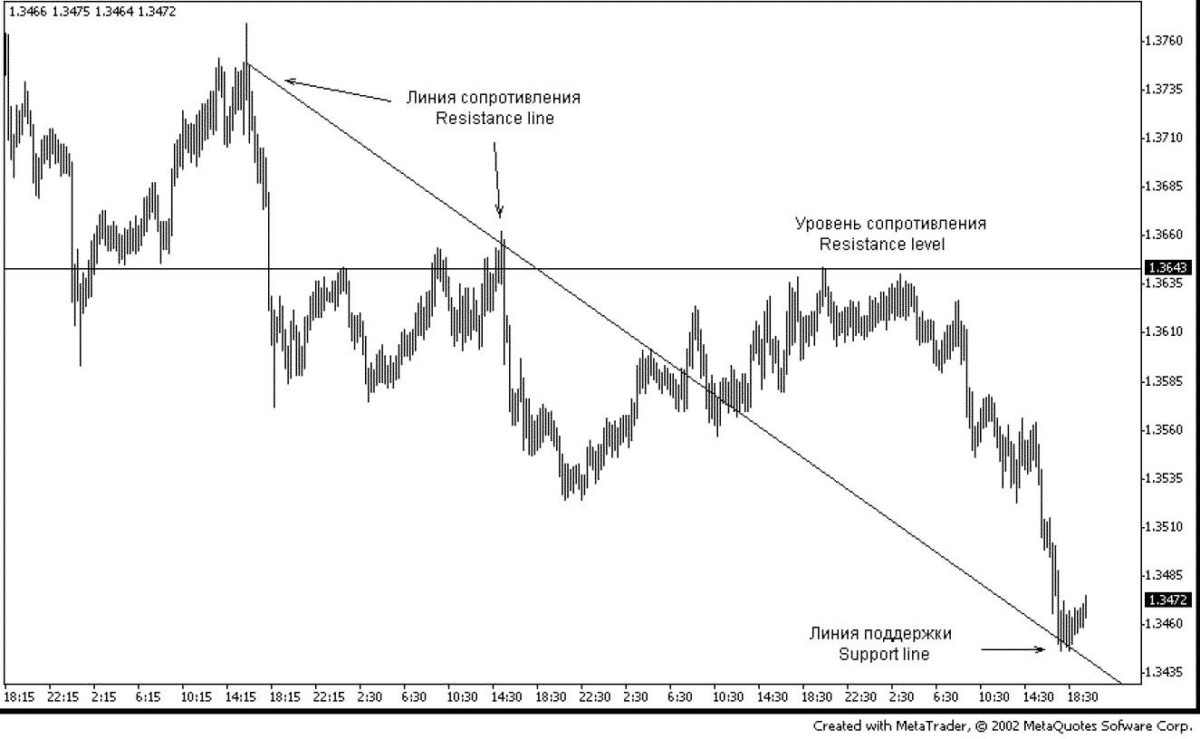
Forex trading for beginners Part 8: Trendlines

Forex trading for beginners Part 6: Consumer demand indicators

Fundamental data, market psychology, and decision making
We understand fundamental analysis as the study of events that occur outside the charts of exchange rate quotes but affect these exchange rates. Generally speaking, everything in the world, even the weather, can influence exchange rates. They say it was useful for Italian lira traders to focus on meteorologists’ forecasts: if the weather is good, the flow of tourists increases, and please – the lira exchange rate is growing! Why not a fundamental factor of the foreign exchange market… Now, of course, you can ignore the European weather; in some ways, it became easier for traders.
To not dump everything in one heap, it is customary to classify fundamental factors into four categories: economic factors, financial policy, political events, and crises.
In this material, we focus on economic factors and some elements of financial policy. They are the main subject of study in fundamental analysis because there is a direct causal relationship between the economy and financial markets. A currency trader should understand the nature of this connection and the meaning of the main financial and economic indicators. The rest is a matter of technique, more precisely, of technical analysis. Charts of economic indicators, like any charts, have their trends, lines, levels of support and resistance, and their mutual correlations. This means they are subject to the same analysis as exchange rate charts using technical analysis tools.
On the positive side, economic data and key financial indicators are published widely, at least for the major market economies, and released at predetermined times.
Based on the previous history and forecasts, the market creates its own opinion about the expected values of the indicators, from which the market mood for each currency follows – to move it up or down. This opinion of each trader can be based on their analysis of economic data charts or a comparison and intuitive weighing of the views of various experts and commentators. It is best if the trader has his assessment, based on which he looks at other views. But the main thing when analyzing and making decisions based on fundamental data is still understanding the opinion of the market. There are no accurate forecasts for the economy, and if the published data differ significantly from what the market expected, then it will not remain indifferent to this. Then, the vigorous course of the exchange rate chart begins,
Each indicator has a natural connection with the behavior of exchange rates simply by its economic content. Therefore, one can easily imagine a table with recommendations of this type: if such and such an indicator has grown, the exchange rate will rise. But, whether such a reaction of the market will take place, or there will be no reaction, or the exact opposite will happen, depends on how the market came to its current state, what are the perceptions of current events by traders and their expectations for the future. In short, everything is determined by the mood of the market. There is a general scheme of cause-and-effect relationships, and there are specific moods that fit into this scheme (then the market reaction will be “normal”) or contradict it (then a sharper non-standard market reaction occurs). Let us once again emphasize the psychological nature of the perception of economic data by the market, which introduces deviations in the above table (and without a correct understanding of which real trading on fundamental data is impossible): at the time of publication of an indicator, the most important thing is not the numerical value of this indicator, but – how much this value differs from market expectations. If the released indicator fully coincides with the market’s expectation, then, as a rule, it has already been taken into account by the market (“discounted”) in the price movement. There may not be a special reaction of exchange rates to the published value despite the overall economic significance of the indicator (GDP, inflation, etc.). But if the market expected one thing and completely different figures came out, then the market reaction to significant economic indicators would be
Just in case, we note that the opinion of the market may not coincide with the published forecasts. The professionalism of a trader lies in the ability to distinguish one from the other and in understanding what factors are decisive for the currency markets right now. The importance of this or that indicator for the market does not remain once and for all given. Depending on the current economic and financial market problems, some indicators come to the fore and stay in the traders’ spotlight for some time. Speculation about the expected values of this indicator can move the exchange rate in some direction long before the release of the data. After the publication, the rate can sharply go in the opposite direction by whole percentages only because the published value of the indicator differed from the forecasts by fractions of a percent. But then the focus of the market shifts to other indicators (or to other currencies), and the market shows almost no reaction to this indicator. Although it may show large deviations from forecasts,
Several examples of economic parameters have been at the center of attention of the markets for a long time, suddenly losing all interest in them and others taking their place. This is natural and inevitable because the markets are living organisms in a life in which many things change. The main goal of this book is to help the trader understand the nature of the main economic indicators and to apply this knowledge to practical trading successfully; it is necessary to continuously monitor the life of the market, its problems, changes in sentiment, and reactions. This must be remembered!
An economic indicator snatched from the market context can not only not provide useful information but also disorient a trader. For example, in a textbook for traders or a macroeconomics book, it is written that if such and such an indicator grows, the exchange rate falls. Seeing this on the screen, the trader quickly sells a fair amount of this currency and takes a loss because the exchange rate rises vigorously. Why is this happening? Yes, for example, because a few days before the publication of the indicator, there was a lot of speculation, comments, and opinion polls on the market that showed that everyone was confident in the growth of this indicator, so, during these days, the exchange rate gradually fell, because in anticipation of just such data traders were selling currencies. After data release that confirmed expectations, many have already fulfilled their plans. They are now realizing profits by buying at a low price the currency that they previously managed to sell at a high price. Mass currency purchases will raise their rate, which is enough to ensure a loss for someone who has not followed market behavior all this time.
Technical analysis studies market dynamics to identify the main trends in price movements, predict future market behavior and determine the best prices and times to make transactions. The term “market dynamics” includes the three main sources of information at the technical analyst’s disposal: price, volume, and time.
Let’s formulate three fundamental principles of technical analysis:
- The course (price) takes into account everything. Any factor influencing the price (economic, political, or psychological) is already considered by the market and included in the price. Thus, everything that affects the price in one way or another will affect this very price. With the help of price charts and many combinations of them, the market itself announces its intentions to an attentive analyst, whose task is to correctly and timely interpret these intentions, and knowledge of the motivation of the market wishes is hardly necessary for correct forecasting. Therefore, all that is required for forecasting is to study the price chart.
- Price movement is subject to trends (the direction of price movement). Price charting mainly aims to identify these trends in the early stages of their development and trade according to their direction. Directional price movement is called a trend.
- History repeats itself. This postulate is based on the objectivity of the laws of physics, economics, and psychology. Those rules that were valid in the past are valid now and will also be valid in the future. This is the basis, in fact, of all interpolation methods for predicting the future, which is a repetition of the past.
Three types of trends (trends) in the direction of price movement:
- Rising, bullish (up trend) – prices are moving up
- Descending “bearish” (downtrend) – prices are moving down
- Sideways (flat, whipsaw, sideways trend) – there is no definite price movement direction
Three types of trends (trends) by duration:
- Long-term (main) – a trend from 6 months to several years.
- Medium-term (intermediate) – a trend for 2 weeks to 6 months.
- Short-term (small) – a trend for up to 2 weeks.
Basic laws of price movement:
- an ongoing trend is more likely to continue than to reverse direction
- the trend will move in the same direction until it weakens.
The main instrument of classical technical analysis is a chart of price changes over a certain period. Price and volume charts are depending on what is reflected on the chart.
However, one important fact should be noted before starting to consider the types of charts used in the Forex market. Let’s assume that there is some period. Within it, fluctuations with great variability occur at very short moments. In this case, the spread of prices is large and thus creates a large amount of market noise and second market sentiment, which does not allow for an adequate assessment of the situation in the long term. Momentary fluctuations are excluded when plotting charts, and only the main events for the period selected for analysis are used to eliminate market noise. How are these events identified? At the end moment of the specified time interval, we project the following points:
- The first quote is from the beginning of the interval. This is the opening price (Open).
- The highest quote for the selected period (High).
- The lowest quote for the period (Low).
- Last price per interval. This is the closing price (Close).
Thus, there is a transformation of continuous information into discrete.
Depending on the selected time interval of the chart, the following can be applied:
- Monthly data grouping – Monthly ( M )
- Weekly Weekly ( W )
- Daily Daily ( D )
- Hourly ( H ) _
- Half-hourly
- 15-minute Quarterly
- 5 minute
Main types of charts
Depending on the method of coding price information on the chart, the following types of charts are distinguished:
- Linear – a line chart is a solid line connecting closing prices. Consider that the most significant factor for the analysis is closing prices. Its drawback is ignoring the amplitude of price changes in the selected time interval.

- Line chart (bars) – line chart (bars). It is built as follows: four prices are selected for each period: High (the highest price), Close (closing price), Open (open price), and Low (lowest price). On the chart, the highest price is defined as the upper coordinate of the segment, and the lowest price is displayed as the lower coordinate of the segment. The entire segment reflects the range of price changes for the considered time interval. The opening price determines the dash coordinate on the left of the segment. The same dash on the right displays the closing price.

- Japanese candles(built by analogy with bars). The cardinal difference between Japanese candlesticks and bars is the presence of a rectangle formed in the price range between the opening and closing quotes. This rectangle is called the real body of the candlestick. The candlestick body is white if the opening price is lower than the closing price. The candlestick is black if the opening price exceeds the closing price. Price movement above the candle’s body forms an upper shadow and a lower shadow below the body. The presentation is similar to the representation in bars. A candle with high > low is called a bullish candle; its body is drawn with the former (or not painted over on any other background) color. A candle with high < low is called a bearish candle, and its body is drawn in black (red or different from the main background) color. A candle whose open and close prices are approximately equal, while high and low prices differ greatly, i.e.

Japanese candlesticks appeared in Japan in the 17th century to display market information. Over its long history, this type of chart turned out to be the most developed, which allows it to be used as an independent method of technical analysis.
- Volume charts. It is usually located in the analysis process under the price chart. Tick volume chart. This means that the abscissa shows the volume, expressed not by the money supply but by the number of contracts concluded on the foreign exchange market for a given time interval by the selected interval of the price chart.

TREND ANALYSIS
A trend or trend is a certain price movement in one direction or another. In real life, no market moves in any direction in a straight line. The market dynamics are a series of zigzags: then rise, then fall, then rise, then fail. The direction of the dynamics of these ups and downs forms the market trend. The concept of a trend is the most important in the FOREX market. This, first of all, is connected with the ability to correctly and timely identify the early stages of a trend and act strictly within the existing trend, which, in the end, will allow you to save and increase your capital.
Rule of thumb: “The trend is your friend.”
Corollary: “Don’t work against the trend.”

It is difficult to underestimate the importance of identifying a trend for working in the FOREX market. According to the experience of many traders – working against the trend is nothing but the shortest path to ruin. Neglecting the basic rule of trend analysis increases the risk of losing your money and your investors’ money. On the contrary, following this rule, the risks of trading on the FOREX market are reduced, and capital is multiplied. The main task of trend analysis is to identify a trend at its early stage of formation, as well as to identify the price range of the most likely price shortly, as well as the conditions for the cost to exit this range. The trend in the FOREX market is divided by duration into long-term (over 6 months), short-term (up to 2 weeks), and medium-term. In the direction of price movement, trends are divided into ascending (“bullish”, bullish, up trend),
Resistance Lines:
- Connect important highs (tops) of the market.
- This occurs when customers are no longer able or unwilling to buy a given product at a higher price. The pressure of sellers exceeds the pressure from buyers. As a result, the growth stops and is replaced by a fall. One of the important varieties of resistance lines is resistance levels – lines parallel to the time axis. This is a kind of “fence” on the way of the price chart. The probability of the price breaking through this “fence” is much less than the probability of a “bounce” from it. However, this level becomes a support level after the price breaks through the resistance level (breakout criteria are different for different charts, but usually, it is 20-30 points). The same can be said about the resistance line breakout – it becomes a support line.
Support lines:
- Connect important lows (bottoms) of the market
- This occurs when sellers are no longer able or unwilling to sell a given product at a lower price. The buying urge is strong enough to withstand selling pressure at this price level. The fall stops, and prices start to go up again. One of the important varieties of support lines is support levels – lines parallel to the time axis. This is a kind of “fence” on the way of the price chart. The probability of the price breaking through this “fence” is much less than the probability of a “bounce” from it. However, this level becomes a resistance level after the price breaks through the support level (breakout criteria are different for different charts, but usually, it is 20-30 points). The same can be said about the support line breakout – it becomes a resistance line.

The above chart shows cases where the resistance line is broken, after which it becomes a support line, and when a support level is broken, it becomes a resistance level. Identification and construction of support/resistance levels are two of the main tasks of technical analysis. The level is a certain psychological value of the price, which all traders know and, when approaching, to which traders will try to close their open positions or open new ones in the opposite direction (when reflected from the level). Thus, the behavior of the price chart will change when approaching the level. Knowing the ranges of possible price movement allows the trader to draw up and implement a trading plan. The level building is also important for some trading tactics.
Strength of levels and lines of support and resistance.
The more times prices rebound from a level or line, the more significant these levels or lines are. Another criterion for the significance of these levels (lines) is the length of these levels (lines) in time. Those. If the support level has lasted for three weeks, it is more significant than the one that lasted for three days. The logical basis for this conclusion is that more market participants will enter the market at the support level in three weeks than in three days.
Volume is another way to assess the significance of support or resistance. If a large volume of trade accompanied the formation of the support level, then a large number of contracts passed from one hand to another, and, consequently, the significance of the support level is very high; and vice versa, the importance of the support level is the less, the smaller was the volume of trade.
You can read other chapters.
この記事は次の言語でもご覧いただけます: English Українська Portuguese Español Deutsch Chinese Русский Français Italiano Türkçe 日本語 한국어






